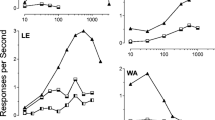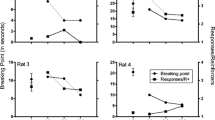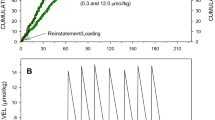Abstract
Under second-order schedules of morphine injection, high rates of responding by squirrel and rhesus monkeys were maintained when morphine was injected intravenously only at the end of each session. Every 30th key-pressing response during a 60-min interval produced a 2-s light; the first 30-response component completed after 60 min produced both the light and intravenous injection of morphine. A mean rate of approximately one response per second was maintained by doses of morphine ranging from 0.75–1.5 mg/kg. A pause in responding after each light presentation was followed by rapid responding until the light was produced again; pauses became shorter as the 60-min interval progressed. When brief light presentations were omitted, but morphine was still injected, response rates decreased and patterns of responding were altered. When saline injections were substituted for morphine injections, but the brief light was still presented, responding decreased markedly within three to five sessions and patterns of responding were altered.
Similar content being viewed by others
References
Byrd, L. D.: Responding in the squirrel monkey under second-order schules of shock delivery. J. exp. Anal. Behav. 18, 155–168 (1972)
Byrd, L. D., Marr, M. J.: Relations between patterns of responding and the presentation of stimuli under second-order schedules. J. exp. Anal. Behav. 12, 713–722 (1969)
deLorge, J.: Fixed-interval behavior maintained by conditioned reinforcement. J. exp. Anal. Behav. 10, 271–276 (1967)
deLorge, J.: The influence of pairing with primary reinforcement on the maintenance of conditioned reinforcement in secondorder schedules. In: Conditioned reinforcement, D. P. Hendry, ed., pp. 61–76. Homewood, Ill.: Dorsey Press 1969
Deneau, G. A., Seevers, M. H.: Pharmacological aspects of drug dependence. Advanc. Pharmacol. 3, 267–283 (1964)
Dews, P. B., Herd, J. A.: Behavioral activities and cardiovascular functions: effects of hexamethonium on cardiovascular changes during strong sustained static work in rhesus monkeys. J. Pharmacol. exp. Ther. 189, 12–23 (1974)
Downs, D. A., Woods, J. H.: Morphine, pentazocine and naloxone effects on responding under a multiple schedule of reinforcement in rhesus monkeys and pigeons J. Pharmacol. exp. Ther. 196, 298–306 (1976)
Ferster, C. B., Skinner, B. F.: Schedules of reinforcement. New York: Appleton-Century-Crofts 1957
Goldberg, S. R.: Comparable behavior maintained under fixed-ratio and second-order schedules of food presentation, cocaine injection or d-amphetamine injection in the squirrel monkey. J. Pharmacol. exp. Ther. 186, 18–30 (1973)
Goldberg, S. R., Kelleher, R. T.: Behavior controlled by scheduled injections of cocaine in squirrel and rhesus monkeys. J. exp. Anal. Behav. 25, 93–104 (1976)
Goldberg, S. R., Morse, W. H., Goldberg, D. M.: Behavior maintained under a second-order schedule by intramuscular injection of morphine or cocaine in rhesus monkeys. J. Pharmacol. exp. Ther. 199, 278–286 (1976a)
Goldberg, S. R., Morse, W. H., Goldberg, D. M.: Some behavioral effects of morphine, naloxone and nalorphine in the squirrel monkey and the pigeon. J. Pharmacol. exp. Ther. 196, 625–636 (1976b)
Gollub, L. R.: The relations among measures of performance on fixed-interval schedules. J. exp. Anal. Behav. 7, 337–343 (1964)
Herd, J. A., Morse, W. H., Kelleher, R. T., Jones, L. G.: Arterial hypertension in the squirrel monkey during behavioral experiments. Amer. J. Physiol. 217, 24–29 (1969)
Herrnstein, R. J., Morse, W. H.: Effects of pentobarbital on intermittently reinforced behavior. Science 125, 929–931 (1957)
Hoffmeister, F., Goldberg, S. R.: A comparison of chlorpromazine, imipramine, morphine and d-amphetamine self-administration in cocaine-dependent rhesus monkeys. J. Pharmacol. exp. Ther. 187, 8–14 (1973)
Hoffmeister, F., Schlichting, U. U.: Reinforcing properties of some opiates and opioids in rhesus monkeys with histories of cocaine and codeine self-administration. Psychopharmacologia (Berl.) 23, 55–74 (1972)
Holtzman, S. G., Villarreal, J. E.: Operant behavior in the morphine-dependent rhesus monkey. J. Pharmacol. exp. Ther. 184, 528–541 (1973)
Kelleher, R. T.: Chaining and conditioned reinforcement. In: Operant behavior: Areas of research and application, W. K. Honig, ed., pp. 160–212. New York: Appleton-Century-Crofts 1966a
Kelleher, R. T.: Conditioned reinforcement in second-order schedules. J. exp. Anal. Behav. 9, 475–485 (1966b)
Kelleher, R. T., Morse, W. H.: Determinants of the specificity of the behavioral effects of drugs. Ergebn. Physiol. 60, 1–56 (1968)
Malagodi, E. F., DeWeese, J., Johnston, J. M.: Second-order schedules: a comparison of chained, brief-stimulus and tandem procedures. J. exp. Anal. Behav. 20, 447–460 (1973)
Marr, M. J.: Second-order schedules. In: Conditioned reinforcement, D. P. Hendry, ed., pp. 37–60. Homewood, Ill.: Dorsey Press 1969
McKearney, J. W.: Effects of d-amphetamine, morphine and chlorpromazine on responding under fixed-interval schedules of food presentation or electric shock presentation. J. Pharmacol. exp. Ther. 190, 141–153 (1974)
O'Brien, C. P.: Experimental analysis of conditioning factors in human narcotic addiction. Pharmacol. Rev. 27, 533–543 (1975)
Seevers, M. H., Deneau, G. A.: Physiological aspects of tolerance and physical dependence. In: Physiological pharmacology, vol. 1, W. S. Root and F. G. Hofman, eds. New York: Academic Press 1963
Vaillant, G. E.: The natural history of urban narcotic drug addiction —some determinants. In: Scientific basis of drug dependence, H. Steinberg, ed., pp. 341–361. London: Churchill 1969
Wikler, A.: Dynamics of drug dependence. Implication of a conditioning theory for research and treatment. Arch. gen. Psychiat. 28, 611–616 (1973)
Wikler, A.: Some implications of conditioning theory for problems of drug abuse. Behav. Sci. 16, 92–97 (1971)
Wilson, M. C., Schuster, C. R.: The effects of stimulants and depressants on cocaine self-administration behavior in the rhesus monkey. Psychopharmacologia (Berl.) 31, 291–304 (1973)
Woods, J. H., Schuster, C. R.: Opiates as reinforcing stimuli. In: Stimulus properties of drugs, T. Thompson and R. Pickens, eds., pp. 163–175. New York: Appleton-Century-Crofts 1971
Author information
Authors and Affiliations
Additional information
This research was conducted at Harvard Medical School, Boston and the New England Regional Primate Research Center, Southborough, Massachusetts, while Dr. A. H. Tang was on leave from the Upjohn Company, Kalamazoo, Michigan 49001, U.S.A.
Rights and permissions
About this article
Cite this article
Goldberg, S.R., Tang, A.H. Behavior maintained under second-order schedules of intravenous morphine injection in squirrel and rhesus monkeys. Psychopharmacology 51, 235–242 (1977). https://doi.org/10.1007/BF00431630
Received:
Accepted:
Issue Date:
DOI: https://doi.org/10.1007/BF00431630




